Customer Support Efficiency with WhatsApp Chatbots
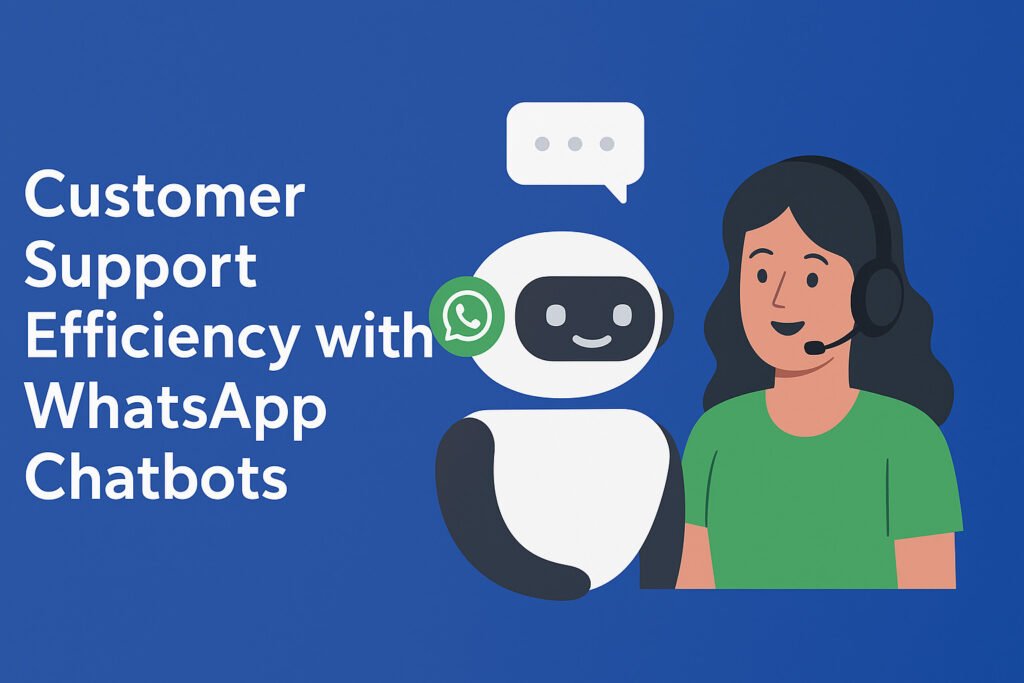
How D2C Brands Can Grow Customer Support Efficiency with WhatsApp Chatbots Introduction For direct-to-consumer (D2C) brands, the pressure to deliver fast, personalized, and consistent customer support is at an all-time high. Customers expect instant replies, 24/7 service, and a seamless experience. The challenge? Doing it all at scale—without ballooning support costs. That’s where WhatsApp chatbots come in. With over 2 billion active users and an open rate of 98%, WhatsApp is the platform where your customers already are. Integrating chatbots into your WhatsApp support strategy empowers your brand to deliver high-efficiency support at scale, without sacrificing personalization. Why WhatsApp Chatbots Matter for D2C Brands WhatsApp isn’t just another messaging app—it’s a customer engagement goldmine. Here’s why: For D2C brands, WhatsApp offers a frictionless channel to manage support, orders, updates, and more—all in one conversational thread. Core Benefits for Support Efficiency 24/7 Instant Responses WhatsApp chatbots never sleep. They can instantly handle FAQs, order inquiries, returns, and common service issues around the clock—no wait time, no frustration. Scalability Without Staffing Increases Your support team can only handle so many queries. A chatbot can handle hundreds simultaneously, reducing wait times and improving resolution rates without growing headcount. Automation Cuts Costs & Boosts Productivity Automating repetitive tasks like tracking updates, FAQs, or product inquiries can save up to 30% in support costs, letting your human agents focus on higher-value conversations. Personalization & Contextual Support at Scale With access to customer data like order history, preferences, and name, WhatsApp chatbots provide contextual, human-like experiences, boosting customer satisfaction while still being automated. Key Features & Best Practices to Implement FAQ Knowledge Base & NLP Integration Train your chatbot with a well-curated FAQ and Natural Language Processing (NLP) for accurate, conversational responses that feel natural. Seamless Chatbot-to-Human Handover When issues get complex, your bot should instantly escalate to a human agent—without losing the context—ensuring a smooth, frustration-free transition. Order Tracking and Real-Time Updates Let customers check their order status, shipping progress, and delivery ETA directly in WhatsApp—automatically and in real-time. Soliciting Feedback & Capturing Insights Use post-conversation surveys or rating prompts within the chatbot to collect valuable feedback and continuously optimize the customer experience. Conversational Commerce & Recommendations Drive revenue during support conversations. WhatsApp chatbots can make personalized product recommendations, recover abandoned carts, and upsell based on chat context. Integrating with CRM & Helpdesk Systems For seamless continuity, integrate WhatsApp with your CRM and helpdesk platforms. This keeps every interaction logged and accessible, ensuring full context across all support touchpoints. Implementation Roadmap for D2C Brands Conclusion For D2C brands striving to scale efficiently, WhatsApp chatbots are no longer a nice-to-have—they’re essential. They deliver instant, automated, and personalized support while slashing costs and improving customer satisfaction. With the right strategy and tools, your brand can handle thousands of conversations without missing a beat. Want to start optimizing your customer service and support? 👉 Explore our guide here.
How to Use WhatsApp to Drive COD to Prepaid Orders
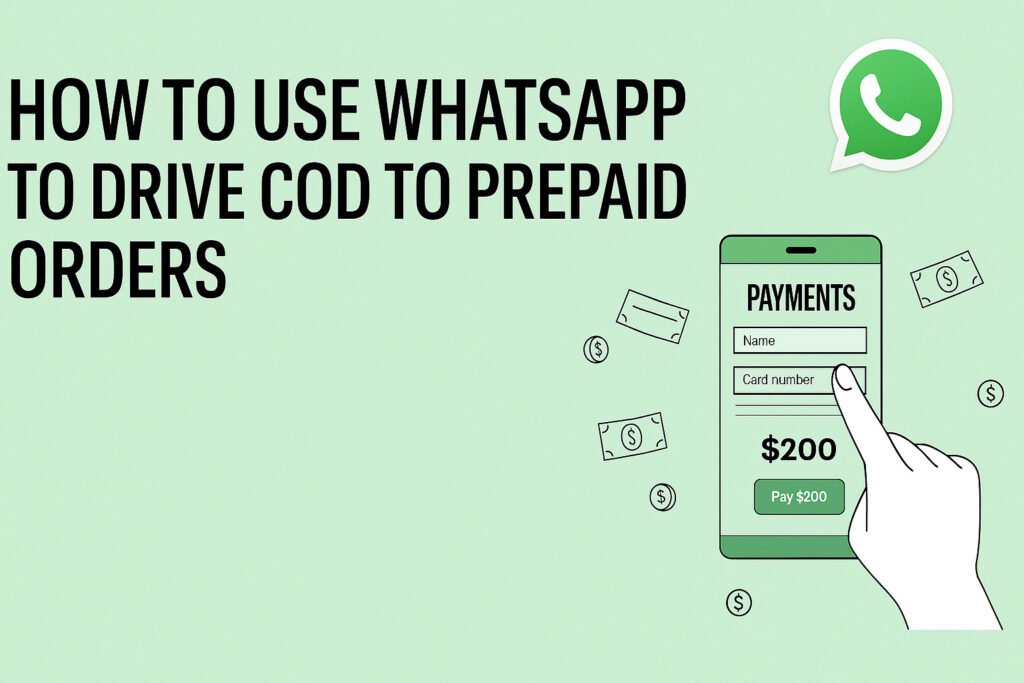
Introduction For most D2C brands, Cash on Delivery (COD) orders are a big part of sales. They make purchasing easier for customers, but they also come with challenges—higher Return to Origin (RTO) rates, delayed cash flow, and wasted shipping costs. Every cancelled COD order impacts profits. One of the smartest ways to solve this is by converting COD orders into prepaid. When done right, this not only reduces RTO but also ensures smoother cash flow. WhatsApp automation can make this process simple, fast, and scalable. This guide explains how to use WhatsApp to convert COD orders into prepaid orders effectively. 1. Why Convert COD to Prepaid Orders? Before we talk about strategies, let’s look at the main benefits: 2. Using WhatsApp to Convert COD to Prepaid a) Send Automated Payment Links When a COD order is placed, send an automated WhatsApp message with a secure payment link. Mention the advantages, such as faster delivery or a small discount, to encourage payment. Example: Hi [Name], thank you for your order! Pay online now and get 5% off plus faster delivery. Your secure payment link: [Link] b) Offer Instant Discounts or Freebies Give customers a small reason to pay upfront. For example: These can be shared instantly through automated WhatsApp flows after the order is placed. c) Create Urgency with Limited-Time Offers A time limit pushes customers to act quickly. For example:Complete your payment within 6 hours and get free express shipping. d) Build Trust with Secure Payment Communication Mention trusted gateways like Razorpay, PayU, or Paytm in your messages. If possible, use your verified WhatsApp Business account with the green tick to boost confidence. e) Send Follow-Up Reminders If the payment isn’t made right away, send reminders: 3. Using WhatsApp Automation Platforms With tools like TheBotMode, you can: 4. Tips to Increase Conversion Rates Conclusion Switching customers from COD to prepaid is not just about saving money—it’s about making your order process more reliable and profitable. WhatsApp automation can help you do this efficiently by sending quick payment links, offering small rewards, and following up at the right time. With the right approach, you can increase prepaid orders, reduce RTO losses, and improve cash flow. TheBotMode can set up your entire COD-to-prepaid system in just a few days, helping your brand scale faster and more profitably.
Optimize COD Orders: Drive Prepaid Adoption via WhatsApp and Reduce RTO
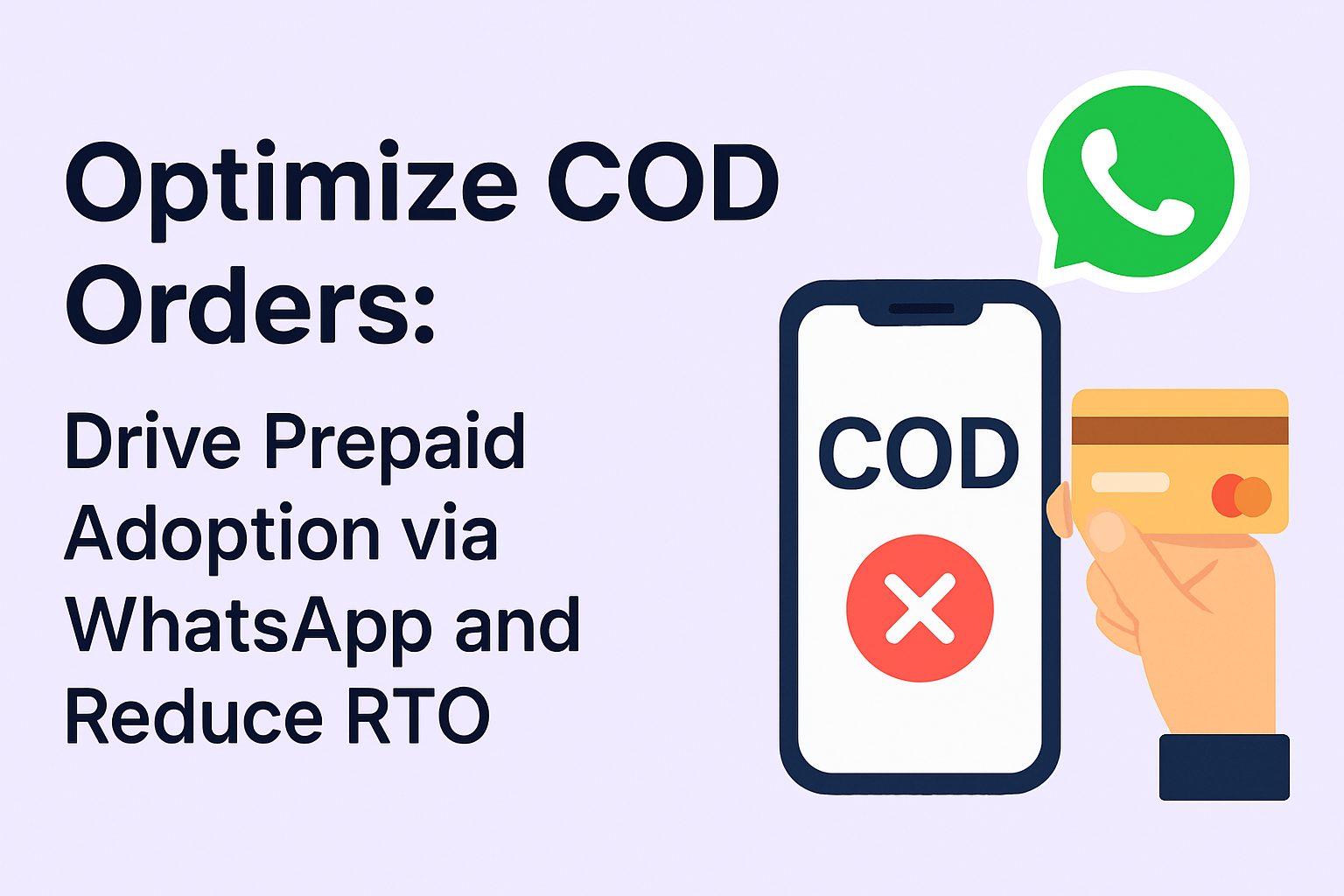
Introduction Cash-on-Delivery (COD) has long been the preferred payment method in India’s e-commerce ecosystem, especially for Direct-to-Consumer (D2C) brands. However, the convenience it offers customers often comes at a high operational cost: Return to Origin (RTO). RTO not only results in lost sales but also increases logistics expenses, warehouse load, and product damage risks. Today, forward-thinking D2C brands are leveraging WhatsApp Marketing, COD verification techniques, and NDR (Non-Delivery Report) workflows to convert cash-on-delivery orders to prepaid, significantly reducing RTO. This blog will guide you on how to do just that. What is RTO, and why does COD make it Worse Return to Origin (RTO) occurs when an order is shipped but fails to reach the customer, prompting its return to the seller. With COD orders, RTO rates are 2–3x higher than prepaid orders due to: These issues not only delay order cycles but also eat into profit margins. Why COD Orders Fail: Key Triggers Missed deliveries, unverified addresses, and lack of customer intent are among the top reasons COD orders fail. Often, customers place COD orders impulsively with no real intention to complete the purchase. By failing to validate customer intent, brands set themselves up for higher RTOs and operational inefficiencies. WhatsApp Marketing: A Game-Changer for COD-to-Prepaid Conversion Why WhatsApp Works for D2C Brands WhatsApp isn’t just a support channel—it’s a conversion machine when used strategically. NDR Management: Stop RTO Before It Happens Understanding NDRs Non-Delivery Reports (NDRs) are triggered when a delivery attempt fails. Timely NDR resolution helps brands avoid automatic returns and gives another chance to salvage the sale. COD Verification: Filter Out Low-Intent Orders Verification Tools That Work Brands using verification have reported up to a 35% reduction in fake or frivolous COD orders. Boost Engagement Before Delivery Use interactive tools to build a relationship with the buyer pre-delivery: Performance Metrics to Track Keep an eye on these metrics: These KPIs will inform you whether your strategy is reducing RTO effectively. Conclusion Reducing RTO and converting COD to prepaid isn’t just about saving costs—it’s about optimizing customer experience, improving cash flow, and scaling sustainably. By combining WhatsApp marketing, COD verification, and smart NDR management, D2C brands can significantly boost prepaid adoption while maintaining operational efficiency. FAQs What is the biggest reason for high RTO in COD orders? Unverified buyer intent and fake orders are the leading causes. How much RTO can WhatsApp marketing reduce? Brands have seen up to a 30% reduction when using automated WhatsApp workflows. Is NDR management only useful for COD orders? While it’s crucial for COD, it also helps recover failed prepaid deliveries with a better customer experience. What tools help automate COD verification and NDR management? Platforms like The Bot Mode, Interakt, and Gupshup offer full-stack WhatsApp automation for D2C needs.
WhatsApp Order Alert: Automate Order Processing and Notifications

WhatsApp Order Alert: Automate Order Processing and Notifications Introduction In today’s fast-paced ecommerce landscape, direct-to-consumer (D2C) brands need to deliver not just products but also instant and reliable communication. Delays in order updates often lead to frustrated customers, increased support tickets, and lost trust. The solution? WhatsApp Order Alerts—automated notifications that keep your customers informed every step of the way. This blog explores how automated WhatsApp messages can streamline order processing, reduce overhead, and dramatically improve the post-purchase experience for your customers. What Is a WhatsApp Order Alert? A WhatsApp Order Alert is an automated notification sent to a customer via WhatsApp whenever a specific stage of their order is completed. These alerts can cover everything from order confirmation, payment verification, processing, shipping, and delivery. Unlike traditional channels like SMS or email, WhatsApp offers real-time updates, rich media formats, and interactive elements like buttons and tracking links—all while maintaining open rates above 95%. Key Stages of Automated WhatsApp Order Flow Order Confirmation As soon as a customer places an order, a WhatsApp message confirms receipt with order details. This builds instant trust and reduces buyer anxiety. Order Processing Notification Once payment is verified or the item is prepared for dispatch, send a status update to keep your customer in the loop. Shipping / In Transit Notify your customer that their package has been shipped. Include the tracking link or live status updates via WhatsApp. Out for Delivery A message sent on the day of delivery ensures your customer is ready to receive their order, minimizing failed attempts. Delivered Confirm successful delivery and include a call-to-action for feedback, ratings, or future offers. Benefits for D2C Brands 1. Increased Open Rates & Engagement WhatsApp messages see 98%+ open rates, far outperforming emails or SMS. This ensures critical order information is never missed. 2. Builds Trust and Transparency Real-time updates enhance customer trust and make your brand appear more professional and reliable. 3. Reduces Support Queries Automated updates dramatically cut down “Where is my order?” (WISMO) inquiries, saving your support team valuable time. 4. Opportunity for Upselling and Feedback You can include personalized product suggestions, catalog links, or ask for reviews, all within your WhatsApp alerts. 5. More Cost-Effective Than SMS No per-message SMS charges or carrier fees. WhatsApp also allows media, links, and interactivity—better ROI. Conclusion A seamless order experience can make or break a D2C brand’s reputation. With automated WhatsApp order notifications, you deliver not only the product but also peace of mind, one alert at a time. From order confirmation to delivery, these messages boost transparency, reduce support overhead, and build long-term customer loyalty. 👉 Ready to get started?Explore our step-by-step WhatsApp Order Alert solution here:Set Up WhatsApp Notifications Now › FAQs Q1: Do I need consent before sending WhatsApp order alerts? Yes. Customers must opt in before receiving business-related WhatsApp messages. Q2: Can I include tracking links and images in WhatsApp alerts? Absolutely. WhatsApp allows links, product images, PDFs, and CTA buttons. Q3: What does it cost to send WhatsApp alerts? It depends on your BSP and location, but it’s usually lower than SMS and offers more functionality. Q4: Is the WhatsApp Business App enough, or do I need the API? For automation, you’ll need the WhatsApp Business API, not just the basic app.
Recover Abandoned Carts Using WhatsApp Automation
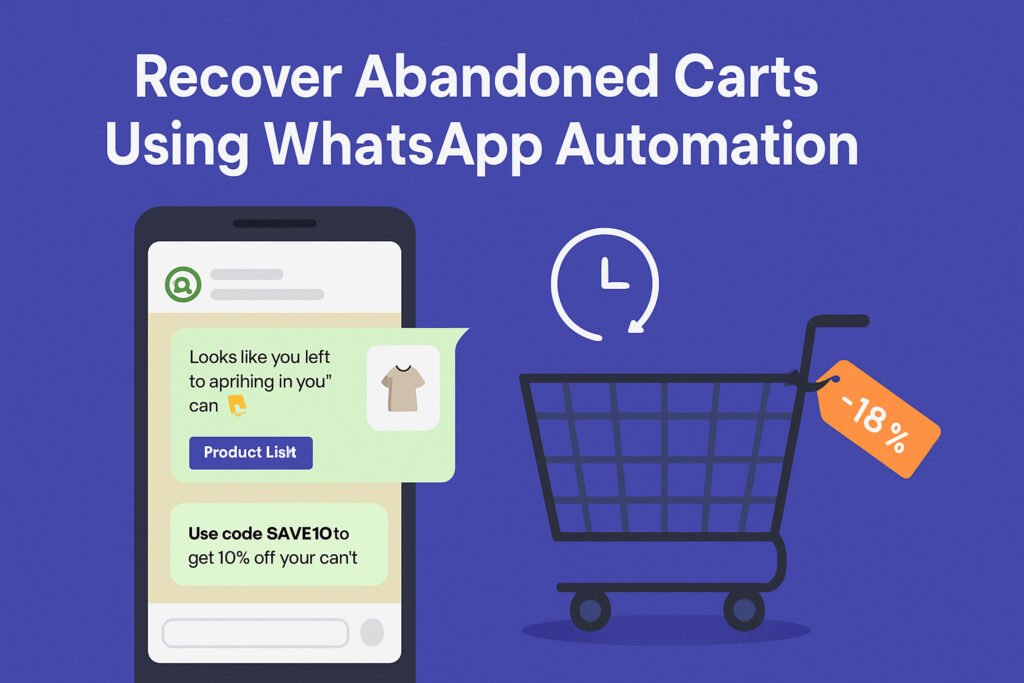
Introduction: Over 70% of online shopping carts are abandoned before purchase. For D2C brands, this means losing out on high-intent buyers. While email reminders are often ignored, WhatsApp automation offers a direct and high-engagement alternative to bring customers back. With open rates as high as 95%, WhatsApp cart recovery automation can significantly improve your sales funnel — and platforms like TheBotMode make it easy to implement. What Is WhatsApp Abandoned Cart Recovery? Abandoned cart recovery on WhatsApp involves automated reminders sent to users who added products to their cart but didn’t complete the purchase. These messages are personalized, timely, and often include incentives like discounts or urgency triggers. Why Use WhatsApp for Abandoned Cart Recovery? How WhatsApp Automation Works for Cart Recovery 1. Cart Abandonment Trigger The automation starts when a customer adds products to their cart but doesn’t check out within a set timeframe (e.g., 30 minutes or 1 hour). 2. Automated Reminder Message Using TheBotMode, you can send a WhatsApp message like: “Hi [Name], looks like you left these in your cart 👀Grab them before they go out of stock: [Product Link]” 3. Follow-Up Reminders If the user doesn’t respond, schedule a second message with a time-sensitive offer: “Still thinking? Use code SAVE10 in the next 2 hours to get 10% off your cart!” 4. Seamless Checkout Include a direct checkout or payment link to reduce friction. Best Practices for Abandoned Cart Automation on WhatsApp TheBotMode’s Abandoned Cart Solution for D2C Brands With TheBotMode, you can: Real-World Results D2C brands using TheBotMode’s WhatsApp cart recovery automation have seen: Conclusion: Abandoned carts are not lost causes. With WhatsApp automation, you can re-engage customers where they are most active. TheBotMode empowers D2C brands with seamless cart recovery workflows that convert interest into purchases — without chasing leads manually. FAQs Q1. Is WhatsApp cart recovery legal in India? Yes, as long as the user has opted in and the templates are approved by WhatsApp. Q2. Can I use this with Shopify? Yes. TheBotMode integrates with Shopify and syncs your cart data for automated recovery. Q3. How many reminders should I send? 2–3 well-timed messages (e.g., after 1 hour, then after 24 hours) are ideal without overwhelming the user. Q4. Do I need a developer to set this up? No. TheBotMode offers a no-code interface that lets you create and manage automated cart recovery flows easily.
Win-Back Campaigns on WhatsApp: Re-engage Inactive Customers
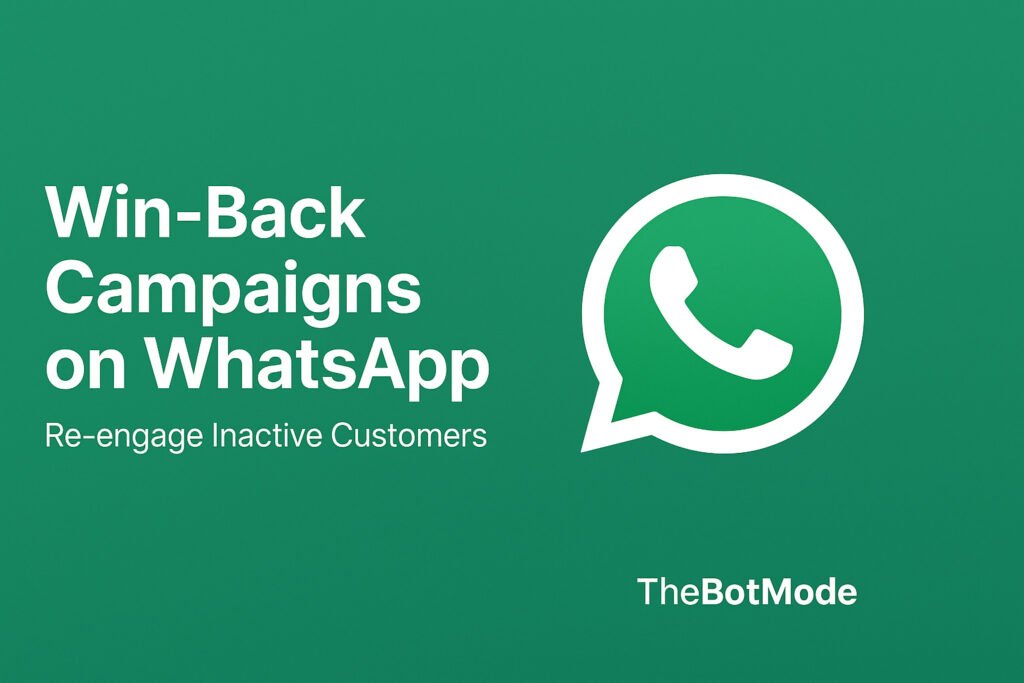
Introduction: D2C brands face a recurring challenge—customers who disengage after making a purchase. Whether it’s a one-time buyer or a once-loyal customer who has gone silent, winning them back can significantly boost retention and lifetime value. With an average open rate of 98%, WhatsApp provides a direct and highly effective channel to reconnect with inactive users. In this guide, TheBotMode breaks down how D2C businesses can create automated win-back campaigns on WhatsApp to drive repeat purchases and customer engagement. What Is a Win-Back Campaign on WhatsApp? A WhatsApp win-back campaign is a targeted message or automated workflow aimed at reactivating customers who haven’t made a purchase or interacted with your brand within a specific period—typically 30, 60, or 90 days. Using the WhatsApp Business API, these messages can be personalized with customer data and sent at optimal times, often with offers or product recommendations to entice the user to return. Top Benefits of WhatsApp Win-Back Campaigns for D2C Brands 1. Lower Customer Acquisition Costs Reactivating existing customers is significantly more cost-effective than acquiring new ones. 2. Boost in Repeat Purchases Timely nudges can rekindle interest and drive spontaneous purchases. 3. Higher Engagement Rates WhatsApp messages often outperform email in open and click-through rates. 4. Personalized Communication Messages can be tailored with customer names, order history, and curated product recommendations. How to Segment Inactive Customers for WhatsApp Win-Back Effective segmentation is key. Use your CRM or eCommerce platform to identify: This ensures your message remains relevant and personalized. Best Practices for Running Win-Back Campaigns on WhatsApp 1. Time It Strategically Start with a 30-day inactivity trigger, and scale up to 60 or 90 days. Increase the incentive based on the time gap. 2. Use Natural, Human Copy Avoid robotic or salesy language. Use friendly openers like: 3. Provide a Clear Incentive Discounts, free shipping, loyalty points, or early access to new drops can work well. 4. Enhance with Media and Buttons Include product images, catalogs, or quick-reply buttons to make the message more interactive. 5. Track Conversions and Refine Use UTM parameters and attribution tools to measure performance. Optimize based on data. Example Win-Back Message Templates Message 1: Comeback Discount Hi [Name], we noticed you haven’t stopped by in a while. Here’s 10% off your next order. Use code COMEBACK10 at checkout. Tap below to explore our latest collection. Message 2: Product Recommendation Based on your last order, we think you’ll love these new arrivals. Have a look—we’d be happy to assist if you need help choosing. Message 3: Feedback and Reconnect How was your last order, [Name]? We’d love your feedback. By the way, some exciting new launches are waiting for you. Automating Win-Back Campaigns with TheBotMode TheBotMode enables D2C brands to fully automate their win-back workflows on WhatsApp. Features include: Conclusion: Re-engaging dormant customers doesn’t require massive budgets—just the right timing, message, and channel. WhatsApp offers a powerful medium to run impactful win-back campaigns. With TheBotMode, D2C brands can automate these journeys, personalize communication, and ultimately improve customer lifetime value. FAQs: Q1. How often should I run win-back campaigns on WhatsApp? You can set up flows for 30, 60, or 90 days of inactivity. The frequency depends on your sales cycle and customer behavior. Q2. Can I personalize WhatsApp win-back messages? Absolutely. You can include names, order history, product preferences, and more using WhatsApp Business API. Q3. Is WhatsApp win-back more effective than email? Yes, especially for D2C brands. WhatsApp often achieves higher open rates and faster responses than traditional email marketing. Q4. What if users don’t respond to the first message? Set up automated follow-up reminders with alternative offers or messaging angles to re-engage them gradually.
Grow Customer Support Efficiency with WhatsApp Chatbots
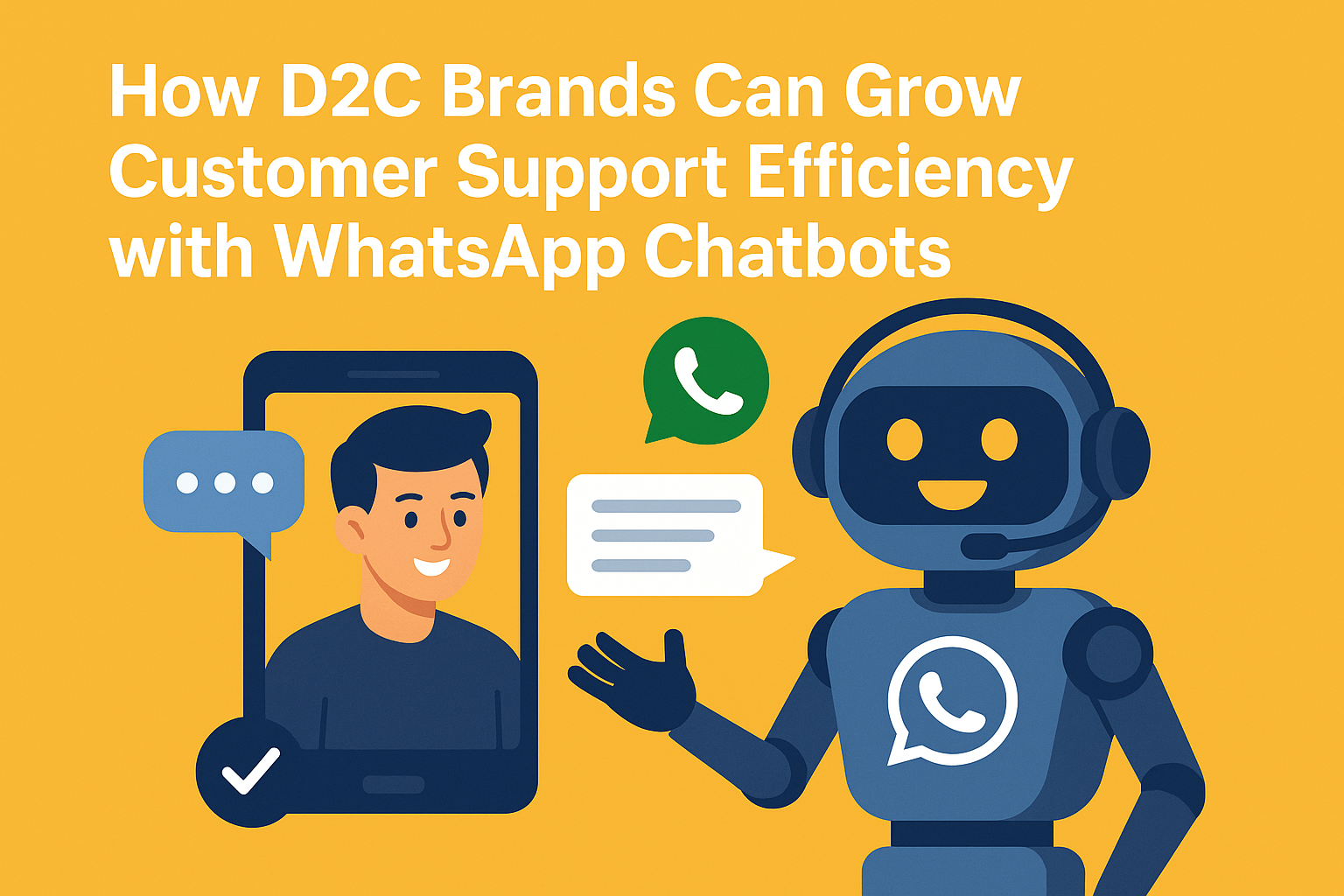
How D2C Brands Can Grow Customer Support Efficiency with WhatsApp Chatbot Introduction For direct-to-consumer (D2C) brands, the pressure to deliver fast, personalized, and consistent customer support is at an all-time high. Customers expect instant replies, 24/7 service, and a seamless experience. The challenge? Doing it all at scale—without ballooning support costs. That’s where WhatsApp chatbots come in. With over 2 billion active users and an open rate of 98%, WhatsApp is the platform where your customers already are. Integrating chatbots into your WhatsApp support strategy empowers your brand to deliver high-efficiency support at scale, without sacrificing personalization. Why WhatsApp Chatbots Matter for D2C Brands WhatsApp isn’t just another messaging app—it’s a customer engagement goldmine. Here’s why: For D2C brands, WhatsApp offers a frictionless channel to manage support, orders, updates, and more—all in one conversational thread. Core Benefits for Support Efficiency 24/7 Instant Responses WhatsApp chatbots never sleep. They can instantly handle FAQs, order inquiries, returns, and common service issues around the clock—no wait time, no frustration. Scalability Without Staffing Increases Your support team can only handle so many queries. A chatbot can handle hundreds simultaneously, reducing wait times and improving resolution rates without growing headcount. Automation Cuts Costs & Boosts Productivity Automating repetitive tasks like tracking updates, FAQs, or product inquiries can save up to 30% in support costs, letting your human agents focus on higher-value conversations. Personalization & Contextual Support at Scale With access to customer data like order history, preferences, and name, WhatsApp chatbots provide contextual, human-like experiences, boosting customer satisfaction while still being automated. Key Features & Best Practices to Implement FAQ Knowledge Base & NLP Integration Train your chatbot with a well-curated FAQ and Natural Language Processing (NLP) for accurate, conversational responses that feel natural. Seamless Chatbot-to-Human Handover When issues get complex, your bot should instantly escalate to a human agent—without losing the context—ensuring a smooth, frustration-free transition. Order Tracking and Real-Time Updates Let customers check their order status, shipping progress, and delivery ETA directly in WhatsApp—automatically and in real-time. Soliciting Feedback & Capturing Insights Use post-conversation surveys or rating prompts within the chatbot to collect valuable feedback and continuously optimize the customer experience. Conversational Commerce & Recommendations Drive revenue during support conversations. WhatsApp chatbots can make personalized product recommendations, recover abandoned carts, and upsell based on chat context. Integrating with CRM & Helpdesk Systems For seamless continuity, integrate WhatsApp with your CRM and helpdesk platforms. This keeps every interaction logged and accessible, ensuring full context across all support touchpoints. Implementation Roadmap for D2C Brands Conclusion For D2C brands striving to scale efficiently, WhatsApp chatbots are no longer a nice-to-have—they’re essential. They deliver instant, automated, and personalized support while slashing costs and improving customer satisfaction. With the right strategy and tools, your brand can handle thousands of conversations without missing a beat. Want to start optimizing your customer service and support? 👉 Explore our guide here.
Recover Lost Sales from Abandoned Carts
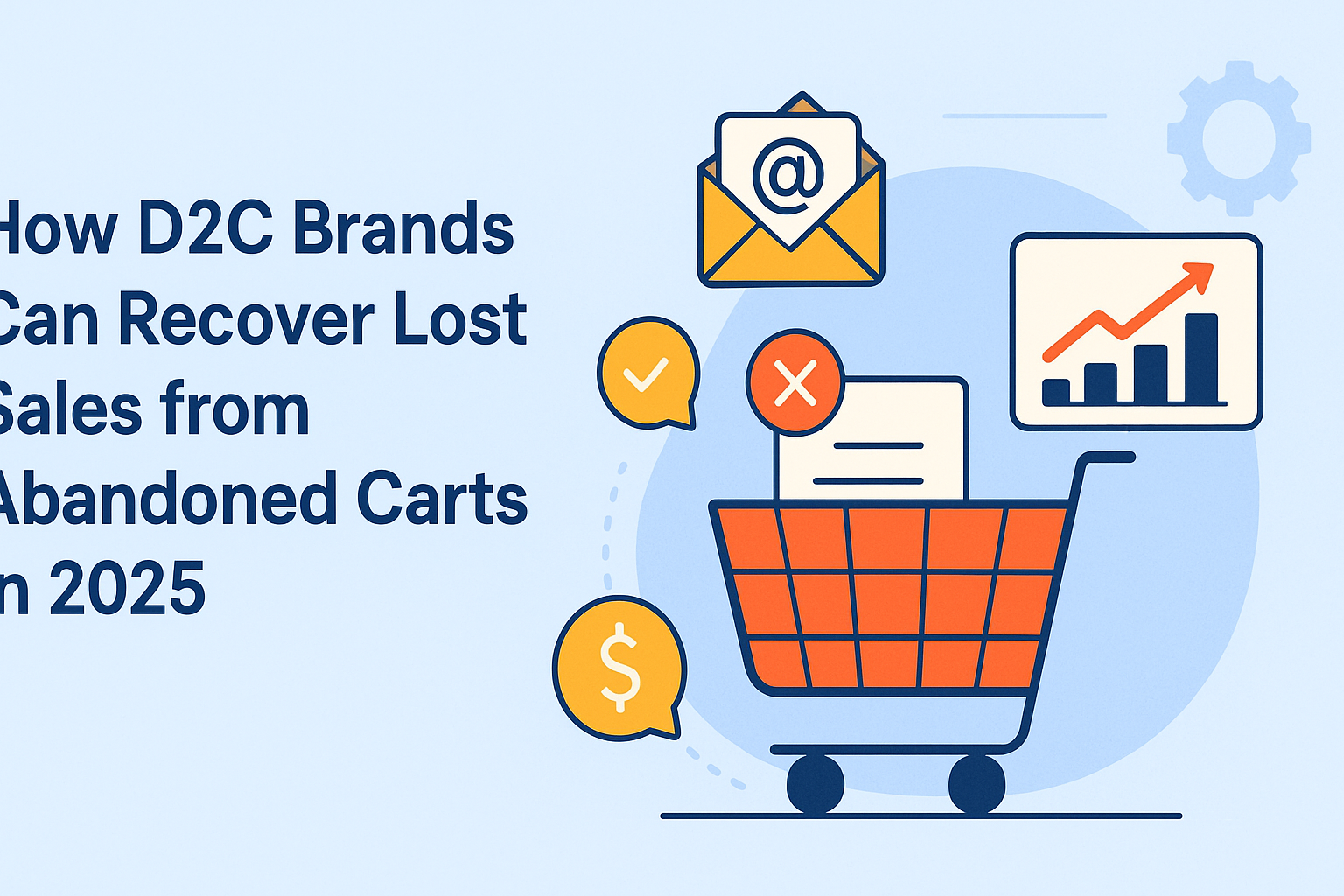
How D2C Brands Can Recover Lost Sales from Abandoned Carts in 2025 Introduction Cart abandonment is a persistent issue plaguing D2C brands. In 2025, with consumer expectations evolving and competition rising, simply getting shoppers to your checkout page isn’t enough. Direct-to-consumer (D2C) brands must proactively combat abandoned carts using modern, personalized recovery strategies. Fortunately, cutting-edge automation tools like The Bot Mode make this easier than ever—helping you recover lost revenue with precision and speed. Understanding Cart Abandonment in 2025 Why D2C Brands Face Higher Abandonment Rates Key Cart Abandonment Stats to Know in 2025 Top Abandoned Cart Recovery Tactics That Work Smart Email Automation Workflows Email remains the foundation of cart recovery. In 2025, top-performing brands utilize: Leveraging SMS & WhatsApp for Immediate Conversions SMS and WhatsApp cut through the clutter and get instant attention. Exit-Intent & Retargeting Popups Use exit-intent technology to catch abandoning visitors before they leave: The Tech Stack D2C Brands Need in 2025 Automation Platforms Like The Bot Mode Using automation is no longer optional—it’s mission-critical. The Bot Mode empowers brands to: Choosing the Right Analytics Tools To continuously improve cart recovery: Best Practices to Maximize Recovery Rates Timing, Segmentation & Offers Testing & Optimization Cycles Real-World Examples of D2C Cart Recovery Success Mini Case Study: Boosting Cart Recovery by 35% Using WhatsApp Automation A D2C brand implemented WhatsApp reminders via The Bot Mode with: 📈 Result: 35% cart recovery boost in 30 days. Common Pitfalls to Avoid Conclusion In 2025, abandoned cart recovery is a key revenue lever for every D2C brand. With advanced tools like The Bot Mode, email, SMS, and WhatsApp automations, and a data-driven approach, your brand can convert lost carts into loyal customers. 👉 Ready to reduce your cart abandonment rate? Start automating with The Bot Mode today. FAQ Section Q1: What is the best way to recover abandoned carts for D2C brands in 2025? The best approach includes multichannel automation—email, SMS, WhatsApp—combined with personalization, offers, and precise timing. Q2: Do abandoned cart emails still work in 2025? Yes, when personalized and timely. They’re even more effective when paired with SMS or WhatsApp reminders. Q3: How many messages should I send to recover an abandoned cart? Typically 3–4 messages across 72 hours perform best: one right after abandonment, one follow-up, and a final offer. Q4: Can WhatsApp really help with cart recovery? Absolutely. WhatsApp’s open and click-through rates far exceed email, especially for mobile-first consumers. Q5: What tools can help automate abandoned cart recovery? Platforms like The Bot Mode integrate email, SMS, and WhatsApp flows while offering analytics and personalization.atsApp flows while offering analytics and personalization.
Top WhatsApp Automation Workflows Every D2C Brand Should Use
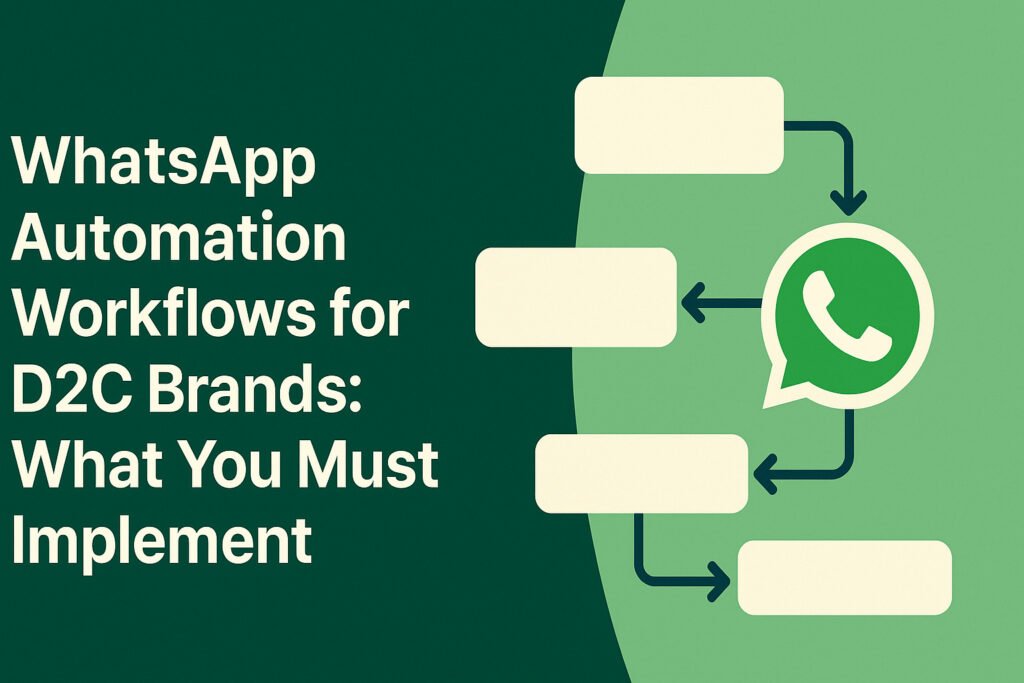
WhatsApp Automation Workflows for D2C Brands: What You Must Implement Direct-to-consumer (D2C) brands are constantly looking for new ways to increase customer engagement, drive conversions, and simplify operations. One of the most effective strategies to achieve all three is implementing WhatsApp automation workflows using the WhatsApp Business API. With the right workflows, your brand can respond faster, convert leads better, and create a more personalized shopping experience. In this blog, we explore the top WhatsApp automation workflows every D2C brand should use—and how TheBotMode can help you implement them effortlessly. 1. Welcome Message Workflow When a new customer messages your business or opts in via a landing page or ad, an automated welcome message builds instant connection. This workflow can: Why it matters: It creates a warm first impression and improves chances of conversion. 2. Abandoned Cart Reminder Workflow Many customers add products to cart but leave without purchasing. With WhatsApp automation, you can send personalized abandoned cart reminders to re-engage them. What to include: Why it matters: It helps recover lost sales and boosts revenue. 3. Order Confirmation and Shipping Updates Keep customers informed with real-time order updates: Why it matters: It reduces customer anxiety and support queries. 4. COD to Prepaid Conversion Workflow Cash on Delivery (COD) leads to high Return-to-Origin (RTO) rates. WhatsApp can help you nudge COD buyers to convert to prepaid using automation. How it works: Why it matters: Reduces RTO losses and improves cash flow. 5. Feedback and Review Collection Workflow After delivery, WhatsApp can be used to request a quick product review or feedback. You can ask: Why it matters: Social proof builds trust and improves product listings. 6. Reorder and Subscription Reminder Workflow If you sell products with repeat usage (like supplements, skincare, etc.), this workflow is crucial. Automate: Why it matters: It boosts customer retention and lifetime value. 7. Festival and Sale Campaigns Workflow Automate festive campaign workflows to notify customers during key sales: Why it matters: WhatsApp has higher open rates than email, making it perfect for time-sensitive promotions. 8. Customer Support Workflow (Auto-Reply + Live Agent Handoff) Use WhatsApp to provide 24×7 support with automated responses for FAQs and quick escalation to agents. Example: Why it matters: Reduces support load and improves customer satisfaction. How TheBotMode Simplifies WhatsApp Automation TheBotMode allows D2C brands to build, test, and optimize WhatsApp workflows with zero coding. With features like: You get everything you need to launch high-converting WhatsApp automation flows. FAQs Q1. Do I need coding knowledge to create WhatsApp automation workflows? No. With platforms like TheBotMode, you can build automation flows using a visual interface—no coding required. Q2. Can I send WhatsApp messages without customer opt-in? No. According to WhatsApp’s policy, businesses must collect customer opt-ins before initiating automated messages. Q3. How much does WhatsApp automation cost for a D2C brand? Costs vary depending on the platform and usage. TheBotMode offers affordable plans tailored for D2C businesses of all sizes. Q4. Is WhatsApp automation effective for small D2C brands? Yes. Even small brands can automate cart recovery, order updates, and customer support to increase efficiency and revenue. Q5. How do I measure the success of WhatsApp automation workflows? Track key metrics like open rates, click-through rates, conversions, and RTO reduction using TheBotMode’s analytics dashboard.
Festival Marketing on WhatsApp: Campaign Ideas That Work
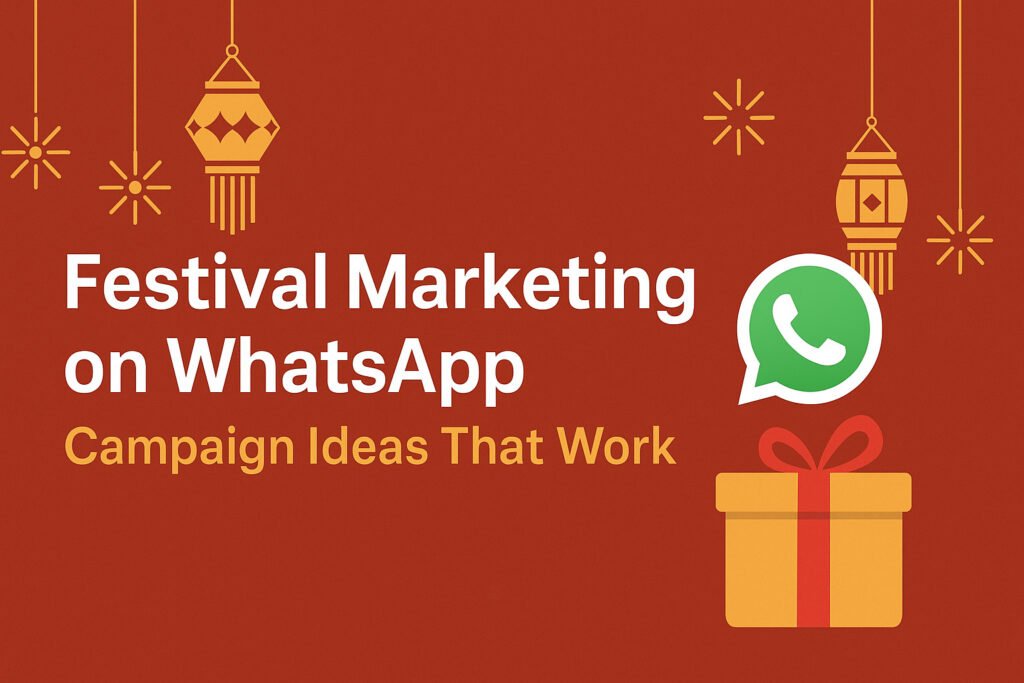
Introduction: In India, festivals are far more than cultural events—they’re peak sales opportunities. From Diwali and Holi to Eid, Christmas, and Raksha Bandhan, consumers are primed to shop. For D2C brands, leveraging WhatsApp for festival marketing can significantly boost engagement, sales, and customer loyalty. Using TheBotMode’s WhatsApp automation tools enables timely, personalized campaigns delivered straight into customers’ inboxes—minimizing reliance on emails or ads. Top Festival Campaign Ideas That Deliver Results 1. Exclusive Festival Offers via WhatsApp Broadcast Send time-sensitive promotional messages to your WhatsApp subscriber list—segment audiences and personalize by name, location, or past purchases. Example: “Hi Riya, celebrate Diwali with 20% off on your favourite kurtis. Offer valid till midnight!” Why it works: High open rates + urgency = instant action. 2. Spin the Wheel Campaigns for Festival Discounts Create interactive gamified campaigns on WhatsApp where users spin to win festival-themed deals like free shipping, limited discounts, or freebies. Best for: Diwali, Navratri, Christmas and festive markets. Advantages with TheBotMode: Run spin-to-win campaigns directly on WhatsApp—no app downloads required. 3. WhatsApp Catalog Promotions with Festive Themes Showcase curated festive collections (e.g. “Diwali Gifting Ideas”, “Eid Special Offers”) in WhatsApp product catalogs, styled with festive banners or limited-time labels like “Only 2 left!” Pro Tip: Use high-quality visuals to guide users and boost urgency. 4. Automated Reminder Campaigns Set up flows to remind customers about cart abandonment or deal expirations. Example Automation Flow: 5. Personalized Gifting Recommendations via WhatsApp Use TheBotMode’s AI logic to suggest tailored gift ideas during festivals like Raksha Bandhan, Valentine’s Day, and Christmas. Personalization drives engagement and purchase intent. 6. Festival Loyalty Campaigns with Rewards Encourage repeat purchases with special loyalty offers.Example: “Buy during Navratri and get double loyalty points!”Send point updates, coupon codes, and personalized rewards directly via WhatsApp. How TheBotMode Helps Automate Your Festival Campaigns Best Timing to Launch Festival Campaigns Festival Ideal Campaign Start Key Focus Diwali 2 weeks in advance Gift combos, flash sales Holi 1 week before Color collections, skincare essentials Raksha Bandhan 10 days beforehand Gift boxes, sibling discounts Eid 7–10 days before Fashion, home decor, accessories Christmas / New Year 2 weeks in advance Combo bundles, new arrivals Conclusion: Festival marketing via WhatsApp isn’t just optional—it’s a competitive advantage. With powerful engagement tools, immediate delivery, and automated flows, WhatsApp enables D2C brands to connect during key buying moments. TheBotMode simplifies launch, automation, and scaling of festival campaigns—no coding required. Ready to launch your next festival campaign on WhatsApp?Visit TheBotMode.com and explore our pre‑built festive flows to get started.













